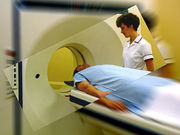No significantly increased risk of parkinsonism for patients with cumulative gadolinium exposure
WEDNESDAY, July 6, 2016 (HealthDay News) — Gadolinium exposure seems not to be associated with parkinsonism, according to a research letter published online July 5 in the Journal of the American Medical Association.
Blayne Welk, M.D., from Western University in London, Canada, and colleagues conducted a population-based study to examine the correlation between gadolinium exposure and parkinsonism. Patients older than 66 years who underwent an initial magnetic resonance imaging (MRI) exam between April 2003 and March 2013 were identified. The primary outcome, a new diagnosis of parkinsonism based on a validated definition, was evaluated in patients who were exposed to gadolinium-enhanced MRIs versus patients who received non-gadolinium-enhanced MRIs. Data were included for 246,557 patients undergoing at least one MRI, of whom 40.5 percent received at least one dose of gadolinium.
The researchers found that the most common initial non-gadolinium-enhanced MRI was of an extremity and that the most common gadolinium-enhanced MRI was of the abdomen (76 and 39.2 percent, respectively). Incident parkinsonism developed in 1.16 and 1.17 percent of unexposed patients and those exposed to gadolinium, respectively. In adjusted analysis, among patients with cumulative gadolinium exposure, there was no significantly increased risk of parkinsonism compared with those exposed to non-gadolinium-enhanced MRIs (hazard ratio, 1.04; 95 percent confidence interval, 0.98 to 1.09).
“This result does not support the hypothesis that gadolinium deposits in the globus pallidi lead to neuronal damage manifesting as parkinsonism,” the authors write.
Copyright © 2016 HealthDay. All rights reserved.








